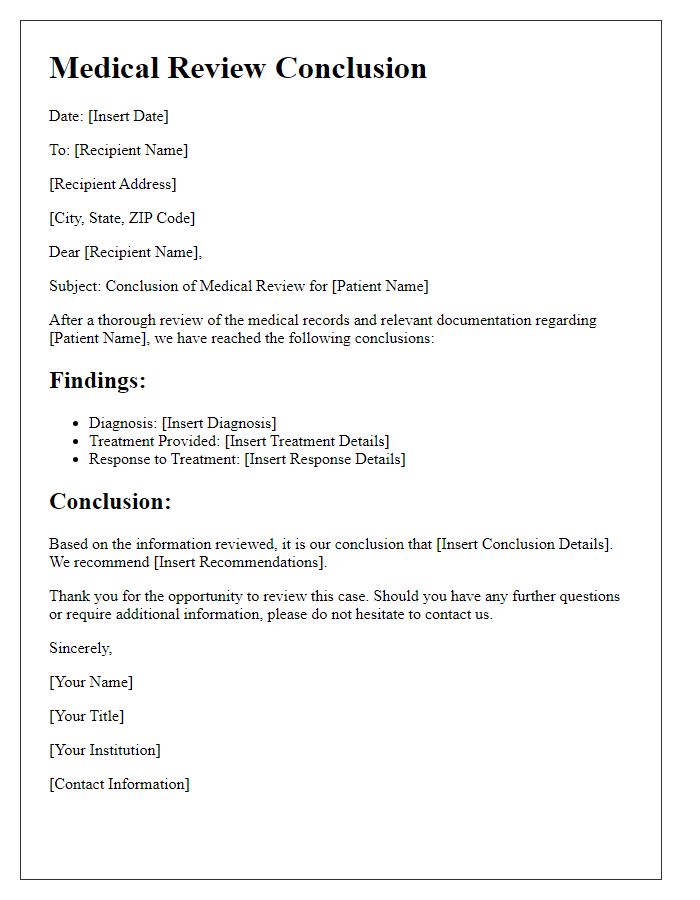Are you looking for a straightforward way to summarize medical examination results? Crafting a clear and concise letter can help ensure that important health information is effectively communicated. In this article, we'll explore an easy-to-follow template that covers all the essential details, making it simple to inform patients or colleagues about key findings. Join us as we delve into the elements of a well-structured medical examination summary!

Patient Information
A comprehensive medical examination summary includes crucial details about the patient. Patient's name (full legal name); date of birth (format: MM/DD/YYYY); gender (male, female, or non-binary); contact information (phone number, email, and address); medical record number (unique identifier for patient history); relevant medical history (previous surgeries, chronic conditions, or allergies); and current medications (list of prescriptions and dosages). Additional important mentions include the name of the examining physician, examination date (specific day of the evaluation), and any referrals or follow-up treatments recommended based on assessed health status. This structured information aids in creating a thorough overview of the patient's health for ongoing medical care.
Examination Details
A comprehensive medical examination summary includes essential details regarding patient assessment, conducted by trained healthcare professionals. Key aspects include the patient's demographics, such as age (e.g., a 45-year-old male) and medical history (notably previous surgeries or chronic illnesses). The examination typically encompasses vital signs, including blood pressure readings (e.g., 120/80 mmHg), heart rate (e.g., 72 beats per minute), and respiratory rate (e.g., 16 breaths per minute). Physical assessments focus on areas such as cardiopulmonary health, abdominal checks, and neurological evaluations to determine overall wellness. Relevant laboratory tests, like blood work or urinalysis, can provide crucial insights into conditions like diabetes or renal function. Radiological evaluations, such as chest X-rays or MRIs, may also be part of the examination, contributing to a thorough understanding of the patient's health status. Follow-up recommendations, including referrals to specialists or further testing, ensure proper management of any identified concerns.
Findings and Observations
The comprehensive medical examination revealed significant findings, such as elevated blood pressure (180/110 mmHg), indicative of hypertension, commonly affecting adults aged 30-55. Physical observations included obesity, with a Body Mass Index (BMI) of 32, pointing toward potential metabolic syndrome. The cardiac assessment recorded a heart rate of 95 beats per minute, slightly above the normal resting range. Notable respiratory findings indicated wheezing, suggesting possible asthma or chronic obstructive pulmonary disease (COPD) in individuals exposed to allergens. Laboratory tests showed high cholesterol levels (LDL above 160 mg/dL), increasing cardiovascular risk. Furthermore, diagnostic imaging did not reveal any acute abnormalities, while the overall examination highlighted the importance of lifestyle modifications and follow-up evaluations to address emerging health concerns.
Diagnostic Assessment
A comprehensive diagnostic assessment plays a crucial role in evaluating a patient's health status and identifying any potential medical concerns. This assessment typically includes a thorough medical history review, where vital information such as past illnesses, medications, and family medical history is documented. The physical examination, which may involve measuring vital signs like blood pressure (normal range: 90/60 mmHg - 120/80 mmHg), heart rate (60-100 beats per minute), and respiratory rate (12-20 breaths per minute), helps healthcare professionals gauge overall health. Laboratory tests such as blood work for glucose levels (normal fasting range: 70-99 mg/dL) and cholesterol (LDL levels ideally below 100 mg/dL) may provide insights into metabolic and cardiovascular health. Imaging studies, including X-rays, MRIs, or CT scans, can further assist in diagnosing conditions related to bones, organs, and soft tissues. Together, these components create a robust framework for understanding a patient's health, guiding further treatment decisions and interventions.
Recommendations and Follow-up
A thorough medical examination, conducted at St. Francis Medical Center on October 15, 2023, revealed several key findings regarding the patient's health. The physician recommends regular monitoring of blood pressure, indicating a reading of 140/90 mmHg, which suggests stage 1 hypertension. Lifestyle modifications, including a balanced diet rich in fruits and vegetables, and regular aerobic exercise such as brisk walking for at least 150 minutes weekly, are advised to manage weight and improve cardiovascular health. Follow-up consultations should occur every three months to reassess blood pressure levels and medication efficacy, particularly considering the potential need for antihypertensive medication if lifestyle changes do not yield positive results. Additional lab tests, including lipid profile and fasting glucose tests, should be scheduled within six months to evaluate cholesterol levels and potential diabetes risk. The patient is advised to maintain a symptom diary to track any changes in health status and report them during the next visit.













Comments